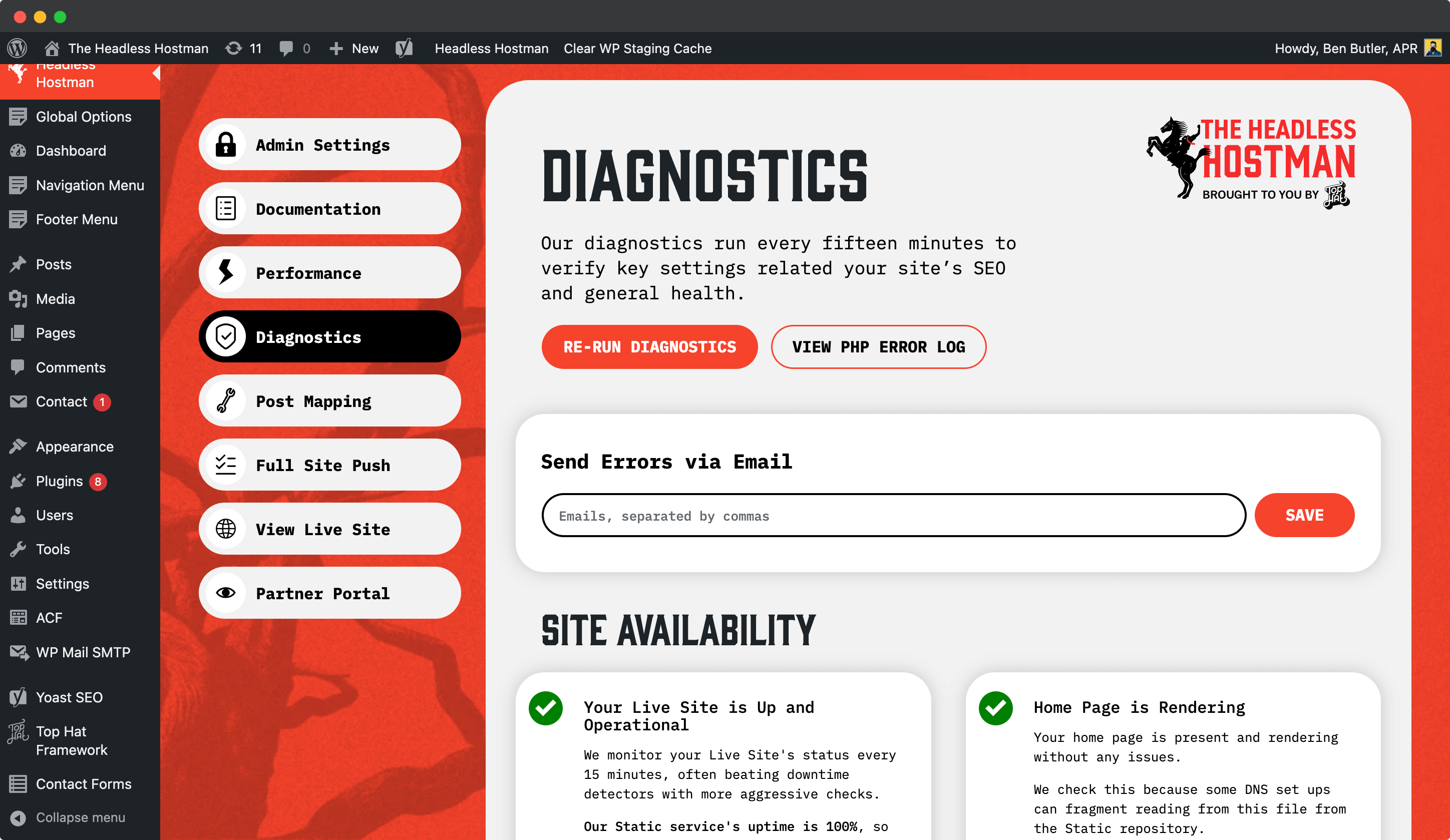How to Achieve SEO for a Static Website
One of the biggest myths about static WordPress sites is that you “lose your SEO.” That can certain be the case if you pick the wrong Static solution. Here’s the lowdown on SEO for static websites, and how we keep your score in tact with the Headless Hostman.
Traditionally, SEO for Static Websites Can be Challenging
Traditional static site solutions — especially those built on JavaScript frameworks like Next.js, Gatsby, or Nuxt — are fast, but they introduce serious complexity when it comes to SEO.
- The decoupled model means your WordPress backend is now just an API.
- All the critical SEO data — meta titles, descriptions, canonical URLs, Open Graph tags, schema markup, sitemap references — now have to be manually mapped and injected into the frontend code.
That’s fine if you’re a developer with time to spare.
But for marketing teams and content creators? It’s a nightmare. Previewing content becomes unreliable. SEO plugins like Yoast or Rank Math lose their automatic power. You have to write custom logic just to ensure each blog post has the right title in the HTML <head>. And forget about real-time optimization — any change to metadata requires code changes, build steps, and a redeploy.
And even when it’s set up correctly, JS frameworks often delay content rendering until hydration or interactivity kicks in. That means slower perceived loads for crawlers, potential indexing issues, and missed opportunities in Core Web Vitals, especially Largest Contentful Paint (LCP) and Cumulative Layout Shift (CLS).
Put simply: traditional static isn’t always SEO-friendly. It’s developer-first, not search-first. And unless you’re wiring every field by hand, your content’s visibility can suffer.
But Wait … There’s a Better Way. At Headless Hostman: We Solve SEO for Static Websites

Say Hello to the Headless Hostman
If you’ve already invested time optimizing your pages with tools like Yoast SEO, RankMath, or All in One SEO, don’t worry, we keep all of that intact.
Your metadata, titles, descriptions, Open Graph tags, Twitter Cards, and schema markup? They come with us.
We take a complete static snapshot of your site and preserve everything that matters for search engines. Every meta tag, every JSON-LD block, every canonical URL—locked in, exactly as your SEO plugin intended.
We Push More Than Just HTML
Our system doesn’t just generate pretty flat pages. We also handle your SEO infrastructure:
- Structured data (schema) from Yoast, RankMath, or manual JSON-LD is included in every build.
- robots.txt is captured and deployed exactly how your WordPress site defines it.
- sitemap.xml is rebuilt and re-linked to reflect the new static URLs (including subdirectory-masked pages, if used).
- Canonical tags remain untouched so your original search strategy stays fully intact.
No Rewrites. No Relearning.
You don’t have to learn a new SEO system or reconfigure anything. Just keep doing what you’re doing in WordPress. We take it from there. Whether your site uses:
- Yoast with focus keywords and social previews
- RankMath’s advanced schema and AI suggestions
- Custom meta fields or hardcoded SEO blocks
We don’t strip it out. We don’t guess. We capture your WordPress-rendered output and serve it as-is—only faster, safer, and way more scalable.
Yes, Search Engines Still Index Static Sites
This is the part that surprises most people: Google actually loves static sites. They’re fast, reliable, and serve exactly what the crawler expects. With Headless Hostman, your static build is SEO-optimized, sitemap-submitted, and ready for indexing.
Static Sites Have Potential to Rank Higher
Why? Because they’re faster. When you’re going for SEO, you need to have a need for speed.
And We Help You Go Faster
To help you speed things up, we unveiled a complete in-platform performance suite. With it, we optimize your HTML during conversion to help it play better with Google Pagespeed Scores.
We achieve all of this without the use of a single Plugin.
Our Shortlist of Performance Enhancements
- Critical CSS Generation (Above-the-Fold)
- Defer Stylesheets Intelligently
- Remove Unnecessary Gutenberg CSS
- Lazyload Images and Backgrounds
- Preload Images for First Contentful Paint
- Convert Backgrounds to Image Tags When Needed
- Add Missing Image Dimensions
- Make Scripts Non-Render Blocking
- Lazyload iFrames on Scroll
- Defer Below-the-Fold Rendering Using Content Visibility
- Minify HTML and Remove Whitespace Bloat
Get the full scoop on making your Static WordPress site faster here.
Don’t Use Any WordPress SEO Plugins Yet? It’s Easy
In order to push the following, they need to be present on your WordPress site:
- Structured data (schema)
- robots.txt
- sitemap.xml
- Canonical tags
If you’re not using an SEO Plugin already, and aren’t doing it manually in site code, then you’ll need to leverage Yoast, RankMath, or another similar Plugin.
- Download, install, and be sure you’re setting the proper set up information.
We’ll handle the rest.
We Also Protect SEO for Static Websites in Our Diagnostics Center

The Diagnostics Center in Headless Hostman keeps your static site healthy 24/7.
While most platforms leave you guessing, we continuously monitor key indicators like indexability, sitemap availability, robots.txt presence, meta tags, and HTTP status codes for critical pages. If something breaks or gets misconfigured, you’re the first to know before Google tells you.
It’s like having a built-in SEO safety net, designed to catch issues before they impact performance or rankings.
SEO Is More Than Just Foundations
Getting your structured data right and preserving all your SEO metadata is critical. But if you want to rank higher, hold your ground, and outrank the competition, you need to go beyond the basics.
Build a Keyword Strategy
A good keyword strategy is not just stuffing words onto a page — it’s about targeting buyer intent and mapping your pages to real searches.
- Use SEMrush to find not just what keywords people are using, but where your competitors are weak. Look for keywords they rank #5–15. Research and pounce.
- Cluster your keywords. Don’t just optimize one page for one keyword. Think clusters: core keywords plus long-tails that support it.
- Reoptimize old content. Once your site goes static with Headless Hostman, old blog posts become lightning fast. That’s a perfect excuse to go back, tighten up keywords, and make minor edits to trigger reindexing.
SEMrush’s Keyword Gap and Content Gap tools are incredibly powerful tools. Find the gaps, fill them better than your competitors, and let the static speed advantage carry you up the rankings.
Build the Right Backlinks
Backlinks are still the lifeblood of SEO. But the days of “spray and pray” linkbuilding are over. You need surgical, strategic backlinks to authority sites.
- Cover the Directories: these are easy wins. Your business information consistently spread across business directories.
- Refresh and Relaunch: Pick your top 5 best posts, update them slightly, and reach out to blogs and sites that linked to similar (but older or slower) content.
- “Hey, I noticed you linked to [X]. We just launched an updated, faster, better guide—would love for you to check it out.”
- Guest Post with a Purpose: Don’t just guest post for the sake of it. Pick topics that directly link to your SEO focus pages. Tie the backlink anchor text naturally into your keyword clusters.
- Create Linkable Assets: Free tools, templates, infographics, and original research—static sites serve these blazingly fast, making people more likely to link because they trust the loading experience.
SEMrush’s Backlink Audit and Link Building Tool will help you prioritize sites worth pitching—and tell you which links to disavow if needed.
Bonus: Spy, Steal, and Strategize with SEMrush
SEMrush isn’t just for keywords. Use it like a hacker:
- Traffic Analytics: See which pages drive traffic to your competitors, then make a better, faster version on your static site.
- Position Tracking: Set up alerts to know when you (or your competition) gains or loses a keyword position.
- Page Speed Tracking: Pair SEMrush’s site audit tool with Headless Hostman’s performance suite to prove how much faster you are than the competition—and shout it from the rooftops in your marketing.
Bottom Line: SEO + Static = Unstoppable
With Headless Hostman, you’re not just preserving SEO—you’re weaponizing it:
- Foundation? Covered.
- Speed? Upgraded.
- Indexing? Streamlined.
- Competitive strategy? Now deadly.
You don’t lose SEO by going static—you just lose the lag.
So if you’re serious about dominating your niche, it’s time to combine killer keyword targeting, relentless backlink building, and intelligent tooling—and let your new faster, lighter site do the rest.
Deeper into the Abyss


